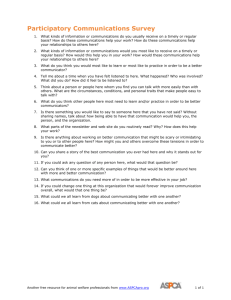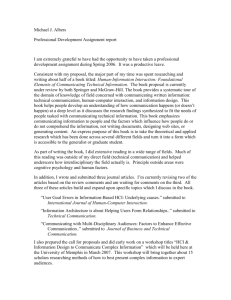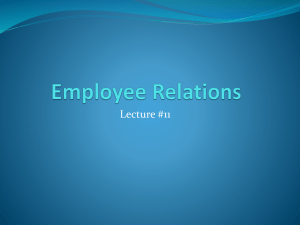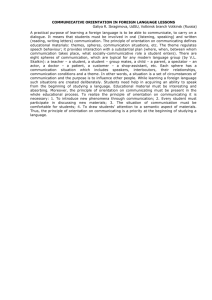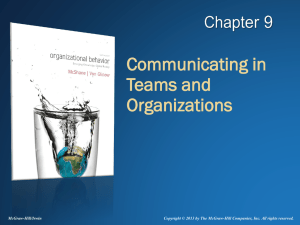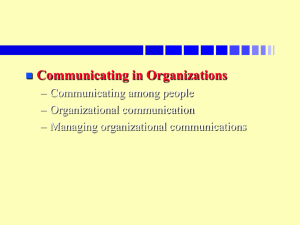View File
advertisement
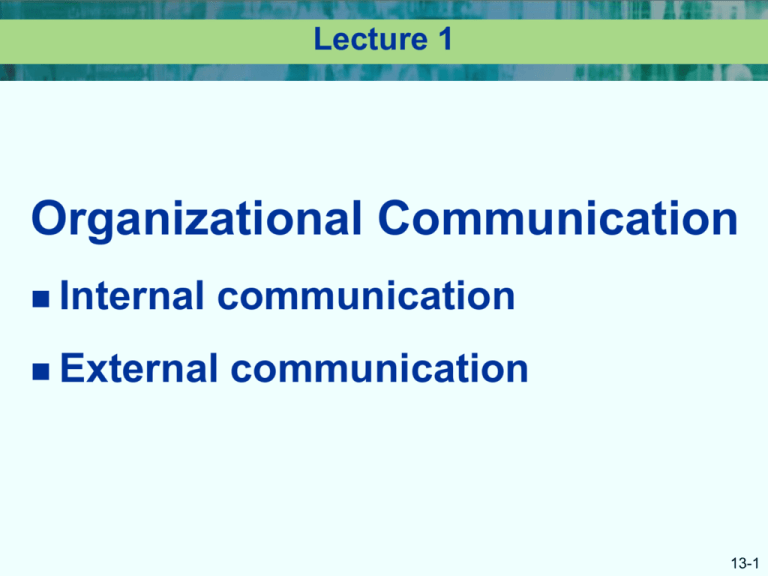
Lecture 1 Organizational Communication Internal communication External communication 13-1 Introduction Planning, organizing, leading, and controlling all involve communicative activity ■ The glue that holds organizations together 13-2 The Importance of Communication Accomplish individual and organizational goals Communication helps organizations Implement and respond to organizational change Coordinate activities Engage in virtually all organizational relevant behaviors 13-3 The Importance of Communication Communication breakdowns are pervasive Ineffective communication = ineffective organizations Informal remarks are distorted Kidding leads to anger Problems arise when… Directives are misunderstood 13-4 The Importance of Communication Communication itself is unavoidable in a functioning organization ■ Only effective communication is avoidable Everything one does communicates something, in some way, to somebody ■ The only question is, “With what effect?” 13-5 The Communication Process 13-6 How Communication Works Effective communication ■ ■ Common understanding between a communicator and a receiver Verbal or nonverbal common symbols are used to convey information In an organizational, internal information flows ■ ■ ■ Vertically Horizontally Diagonally 13-7 Communicating Within Organizations Downward Communication Flows from higher levels in the hierarchy to those in the lower levels Includes job instructions, memos, policy statements, procedures, manuals, company publications Often incomplete, inadequate, and inaccurate 13-8 Communicating Within Organizations Upward Communication ■ Communicator is at lower level than receiver ■ Includes suggestion boxes, group meetings, and appeal or grievance procedures 13-9 Functions of Upward Communication Provides managers feedback about problems, organizational issues, day-to-day operations Is management’s primary source of feedback Relieves employee tension by allowing lowerlevel organization members to share relevant information with superiors Encourages employees’ participation and involvement, thereby enhancing organizational cohesiveness 13-10 Horizontal Communication Necessary for coordination and integration of diverse organizational functions Often necessary for coordination Can provide social need satisfaction Facilitation often left to individual managers 13-11 Communicating Within Organizations Least-used channel of communication Diagonal Communication Important where members cannot communicate effectively through other channels Sometimes the most efficient communication method, in terms Of time and money 13-12 Organizational Communication External Communication 13-13 Communicating Within Organizations Communicating Externally ■ Present products, services, positive image ■ Attract employees ■ Gain attention Typically used for… ■ Public relations ■ Advertising ■ Promoting ■ Customer/client/patient surveys 13-14 Information Richness The amount of information that can be transmitted or communicated effectively ■ ■ Face-to-face interactions are high in richness A general email to employees is low in richness A medium with high richness ■ ■ Likely to result in common understanding “Real time” communication permits instant feedback 13-15 Common Communication Media 13-16 How Technology Affects Communication Internet/Intranet/E xtranet Email, Messaging Smart Phones Videoconference Social Networks Voice Mail Teleconference eMeeting/ Collaboration 13-17 Intranet Versus Extranet Intranet • Private, protected electronic communication system within an organization Extranet • Connects employees with individuals external to the organization • Used to communicate proprietary and organizationspecific information 13-18 Improving Communication in Organizations To become a better communicator ■ Strive to be understood ■ Strive to understand 13-19 Techniques to Improve Communications Following up Regulating information flow Utilizing feedback Empathy Repetition Encouraging mutual trust Effective timing Simplifying language Using the grapevine 13-20 Promoting Ethical Communications Kreps’ principles for internal organizational communications ■ Do not intentionally deceive another ■ Do not purposely harm an organization member ■ Treat organizational members justly 13-21
